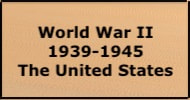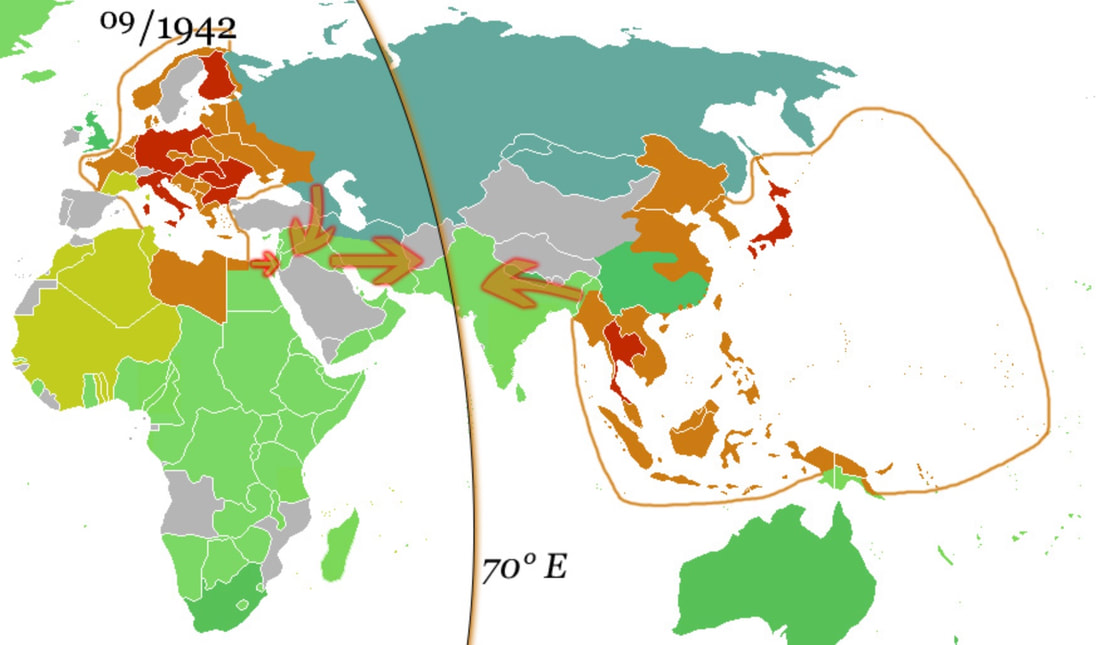bigpigeon.us webpage WWII US > WWII Overview, © 2023 by Robert A. Christiansen, links checked by RAC 15 Aug 2022, updated by RAC 13 Dec 2023.
I view WWII as a consequence and continuation of WWI, and treat the United States participation in WWII as consisting of two wars in two different geographic areas
I view WWII as a consequence and continuation of WWI, and treat the United States participation in WWII as consisting of two wars in two different geographic areas
|
As the above map shows, the War with Japan and the War with Germany were quite separate geographically. The four thick arrows show planned offensives that would have brought Japanese and German forces together, but that fortunately never happened.
The red and orange areas represent the Axis powers, their allies, and the territory they occupied as of September 1942. |
The United States was already drifting towards war with both Japan and Germany when the Japanese Empire launched its fateful surprise attacks on December 7, 1941. (December 8 west of the International Date Line.)
- Japan - the United States had imposed economic sanctions attempting to curtail Japan's brutal aggression in China and expansionist tendencies in the southeast Asia area.
- Germany - the United States was taking increasingly bold actions in the North Atlantic to maintain the maritime supply line to Great Britain.
Some comments on my World War II modules scope and perspective:
The names of countries:
You may see different names than those I use for some of the countries that fought in World War II:
About commonwealths and empires during WWlI:
Notes:
- Big Pigeon's WWII Japan and WWII Germany modules focus on United States involvement in WWII. Even though only about 1% of those who died worldwide because of WWII were American, I cover only the American experience.
- My goal - To remember the men and women of the Pottawattamie area in southwestern Iowa who served in WWII but did not survive.
- Thus, my WWII Japan and WWII Germany modules contain about 100 webpages which summarize a battle or campaign followed by a list of those from the Pottawattamie area who died during that event.
The names of countries:
You may see different names than those I use for some of the countries that fought in World War II:
- Russia - Union of Soviet Socialist Republics abbreviated as USSR or The Soviet Union
- China - Republic of China
- Japan - Japanese Empire
- Germany - the Third Reich
- England - Great Britain
- US - United States of America
About commonwealths and empires during WWlI:
- The major countries in the British Commonwealth of independent nations were the dominions of Canada, South Africa, Australia and New Zealand.
- The Philippine Islands were a US commonwealth, scheduled for independence in 1946.
- England, France, the Netherlands, Japan and Italy were empires whose colonies figured prominently in the war.
- The major British colony was India, which included today's countries of India, Pakistan, and Bangladesh.
- Since the British Empire and Commonwealths were major contributors to the Allied armed forces, I will often use British Empire instead of Britain or Great Britain in my text.
Notes:
- Our major WWII enemies, collectively referred to as the Axis, consisted of Germany, Japan and Italy. However, they were supported by a number of smaller nations, ranging from Vichy France in western Europe to Siam (now Thailand) in Southeast Asia. Italy left the Axis early, in the summer of 1943. I focus on the major powers whom the US fought, namely Japan and Germany.
- Throughout my WWII Japan and WWII Germany modules, I use maps to support my text. You can usually enlarge a map or photo by clicking on it.
Sources for Big Pigeon's WWII US > WWII Overview webpage:
- The Proposed Division of Eurasia map, https://en.wikipedia.org/wiki/Axis_powers_negotiations_on_the_division_of_Asia.


